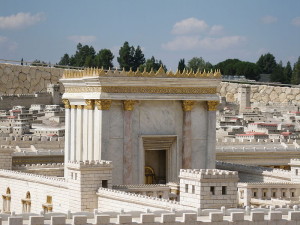Hasmonean Takeover of the Temple, Lawrence H. Schiffman, Reclaiming the Dead Sea Scrolls, Jewish Publication Society, Philadelphia, 1994.
 Immediately following the revolt, there occurred a crisis in the Jewish priesthood that had a direct impact on the formation of the Qumran sect and its establishment in the Judaean Desert.
Immediately following the revolt, there occurred a crisis in the Jewish priesthood that had a direct impact on the formation of the Qumran sect and its establishment in the Judaean Desert.
The Zadokite priests, tracing their ancestry to Zadok, high priest in the time of King Solomon, had occupied the high priesthood virtually without interruption up to the Maccabean revolt. Yet members of this group, known as Sadducees, were also among the extreme Hellenists who had perpetrated the Hellenistic reforms and opened up Judaea to the interference of the Seleucids, the Antiochan persecutions, and the Maccabean wars. However, many Sadducean priests during this period continued to be pious, maintaining the ancient traditions of the Temple in Jerusalem.
As a result of the revolt, the Zadokites lost control of the high priesthood to the Hasmonaeans, the Maccabean family. When the dust of the revolt had settled, Jonathan the Hasmonaean, not of the Zadokite line, had been proclaimed high priest. Hasmonaean takeover of the high priesthood was made permanent only later at an official assembly in the time of Simon- “forever, until a trustworthy prophet should arise” (I Maccabees 14-41).
The change must have been welcome to many elements of the Jewish population. After all, the Zadokites had led the people astray by their corruption in the last years before the revolt. The Hasmonaeans, on the other hand, were looked upon as reformers, ready to maintain the purity and holiness of the Temple and Jerusalem, for which they had fought so valiantly. Only later would those hopes also be dashed, as the Hasmonaean rulers themselves became increasingly Hellenized. But in the flush of victory, the Jews of Palestine hailed the rise of the Hasmonaean high priesthood as signaling a return to the purity of Israelite worship.
However, it is unlikely that the entire population greeted the new regime with unqualified acceptance. The old Zadokites, especially the pious priests, must have bitterly resented Hasmonaean control of the office of high priest. Even more objectionable to them were the changes in Temple practice introduced by the Hasmonaeans under the influence of the Pharisees. From Josephus and talmudic sources, we know that the Pharisees at this time held both political power and religious authority and that their views probably played a large role in the conduct of both government and priesthood, although that role was not as great as the Pharisees themselves might have wanted. Additional proof of Pharisaic hegemony comes from the Dead Sea Scrolls, as we will see.



